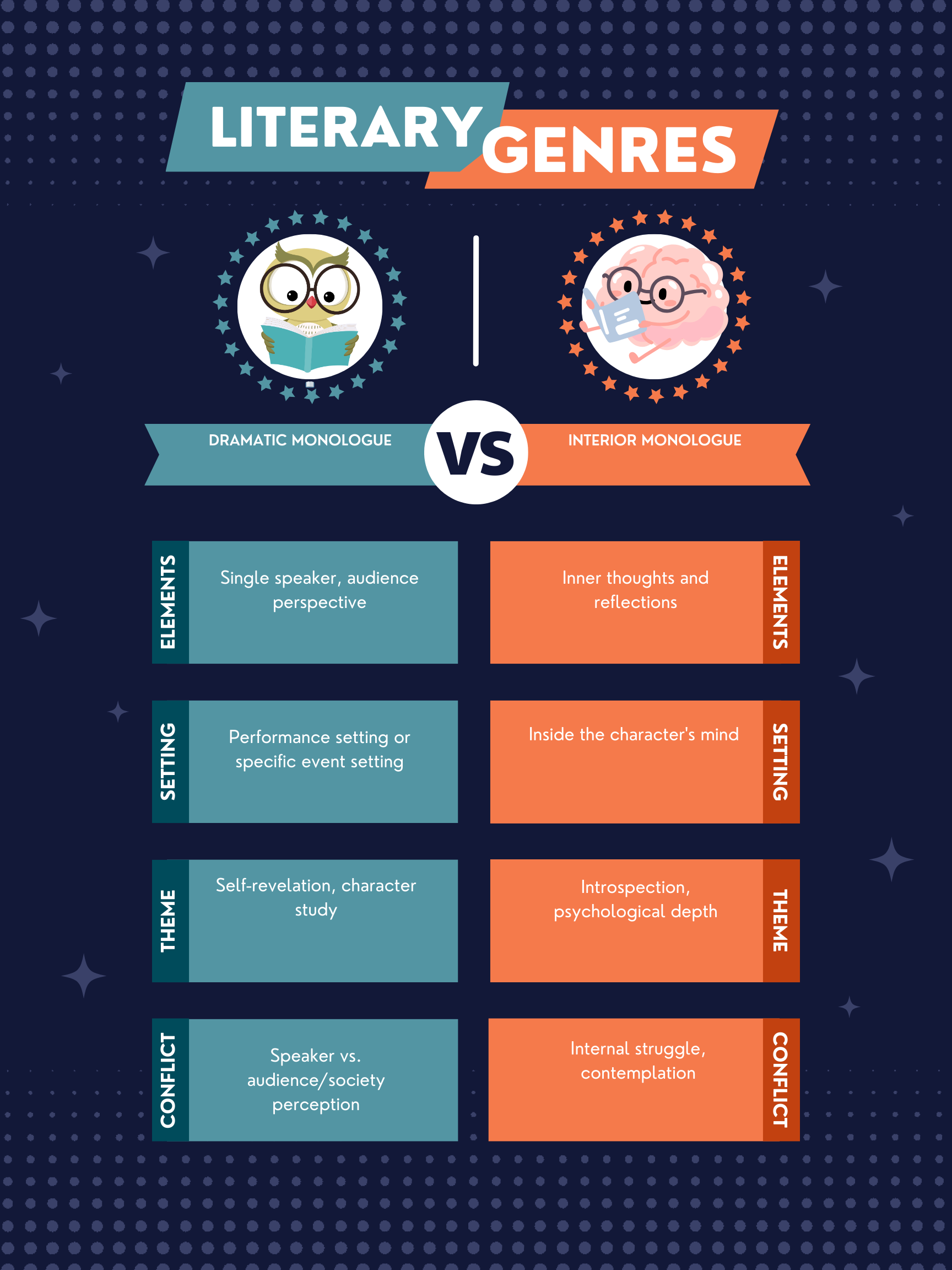Dramatic Monologue is a speech delivered by one character in a play or poem, revealing their feelings and thoughts to the audience; Interior Monologue is a narrative technique that expresses a character’s inner thoughts, sometimes as a stream of consciousness.
Dramatic and interior monologues are powerful literary tools for delving deep into characters’ minds and emotions. Let’s examine how these devices function and what they bring to the narrative table. 🎭💭
Dramatic Monologue
A dramatic monologue is a lengthy speech where a character directly addresses an audience or another character, revealing insights into their personality, motivations, and desires. Robert Browning’s poem “My Last Duchess” is a quintessential example, where the Duke reveals his jealousy and pride while discussing a painting of his late wife.
Interior Monologue
Interior monologue offers a glimpse into the thoughts and feelings swirling inside a character’s mind, often presented as a direct narrative technique. James Joyce’s “Ulysses” famously employs this technique, especially in the “Penelope” episode, which presents Molly Bloom’s thoughts in a stream-of-consciousness style, offering an intimate portrait of her psyche.
Summary
| Literary Device | Definition | Purpose | Usage | Relevant Examples |
|---|---|---|---|---|
| Dramatic Monologue | A speech by one character revealing their thoughts and feelings. | To explore character motivations and personality. | Plays, poetry. | “My Last Duchess” by Robert Browning. |
| Interior Monologue | A narrative technique expressing a character’s inner thoughts. | To provide an intimate glimpse into a character’s psyche. | Novels, short stories. | “Ulysses” by James Joyce. |
Writing Tips
For Dramatic Monologue:
- Craft a Clear Speaker: The character’s voice should be distinct and their perspective clear.
- Reveal Character Through Speech: Use the monologue to uncover deep motivations or secrets.
- Engage the Audience: Although it’s a monologue, ensure the speech is compelling and dynamic.
For Interior Monologue:
- Dive Deep into Consciousness: Allow readers to fully immerse in the character’s thoughts.
- Stream of Consciousness: Consider using this technique for a more fluid and natural thought presentation.
- Balance Clarity and Complexity: While interior monologues can be complex, ensure they remain accessible to the reader.
FAQs
Can a dramatic monologue include interior monologue elements?
Yes, a dramatic monologue can incorporate elements of interior monologue, revealing the speaker’s inner thoughts and feelings to the audience.
How do you differentiate between the two in a narrative?
Dramatic monologue is often more structured and directed at an audience within the story or the reader, while interior monologue tends to be more free-flowing and introspective, lacking direct audience engagement.
Exercise
Read the following excerpt: “She walked through the silent halls, her thoughts racing. ‘Will they understand why I did it? No, they can never know the truth that haunts my every step.’”
Answer: This passage features elements of an interior monologue, providing insight into the character’s inner thoughts and conflicts.
Other Interesting Literary Device Comparisons
- Soliloquy vs Monologue: A soliloquy is a speech delivered by a character alone on stage, revealing inner thoughts, while a monologue might be addressed to other characters.
- First-Person vs Third-Person Narration: First-person narration offers a direct viewpoint from the character’s perspective, while third-person narration provides a broader overview of the story from an outside perspective.
- Direct vs Indirect Characterization: Direct characterization tells the audience what a character is like, while indirect characterization shows it through actions, speech, and appearance.
By exploring these devices, writers and readers alike can deepen their appreciation for the nuanced ways narratives can explore and express the complex layers of character and story. 📘🌟

